Author: Roderick

Information:
- Year of publication: 2019
- Country of origin: USA
- Price: 6800 €
- Structure: open, "over-ear"
- Planar element: 66 mm
- Impedance: 50 ohm
- Sensitivity: 88 dB/mW
- Weight: 640 g without cable
- Connection type: 2 x 3-pin mini-XLR
- Cable: 2.4 metre cable with 4-pin XLR connector and 6.35 mm adapter (length 30 cm)
- The manufacturer sells the headphones with two levels of equipment. The only real accessory in the basic version I reviewed is a cloth pouch. The €10 000 complete version comes with a wooden box, a leather bag and a more expensive cable.
Method of purchase of the review item: self-purchased product
The Abyss AB1266 Phi TC I'm reviewing this time might look familiar to HearingCorner readers at a quick glance, as it is very similar in appearance and construction to the one I recently reviewed. AB-1266 Phi -hearing model (published in 2017). Below the surface, however, the TC model released in 2019 is a different headset, with new planar elements compared to the Phi model and the CC model released in 2018. In this article, I'll go into more detail about the changes the TC model brings to the AB-1266 series, and what it offers for its hefty price of €6800.
Packaging and accessories
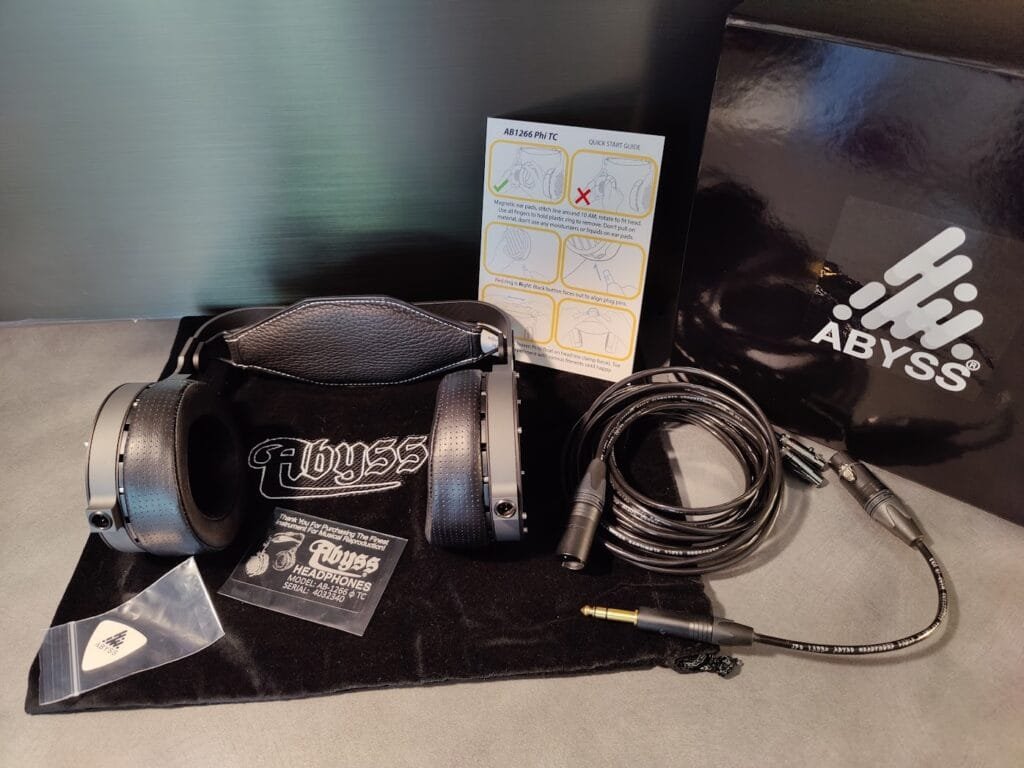
As expected, the lower-priced basic version of the headphones has a limited feature set, as with previous models in the AB-1266 series. There's nothing useful in the cardboard packaging, but the unnecessary bits and pieces include a plectrum and a credit card-like flap with the headphones' serial number. This serial number can also be found on the headphones, so the card has no real function, for example in terms of warranty. The user manual that comes with the headphones is more of a quick reference guide, so it's worth familiarising yourself with how to use the headphones, perhaps with the help of the manufacturer's YouTube channel.
The AB1266 Phi TC no longer comes with the wooden box, which was still included in the more sparsely equipped version of the Phi a few years ago. What I miss the most is a proper bag to easily protect the headphones after listening. The soft protective bag is a good quality bag, but I would prefer to carry and store such expensive headphones in a more protected way. The full package, costing a whopping €10,000, would include a fine leather case, a wooden box and a Superconductor headphone cable, which costs €3,000 to €7,000 when bought separately, depending on length. The basic version comes with a 2.5 metre XLR cable and includes a 6.35 mm adapter about 30 centimetres long.
Quality of construction and comfort of use
The AB-1266 series' unique design is completely different from conventional headphones, as the fixed band does not compress the ear cushions against the user's head at all. There are also tricks to using the headphones correctly, which I have described in more detail in my previous article on the AB-1266 Phi review on. This time, I'll just focus on how the newer TC model differs from its predecessor.

New paint surface:
On the surface, the TC looks very much like the Phi, except that the paint surface has been given a ceramic treatment, which should increase the wear resistance. In fact, the ceramic coating is not entirely new to the AB-1266 series, as it is also found on the CC (Ceramic Coating) model released between the Phi and TC. This was necessary, as small pieces of the Phi's paint surface easily come off.
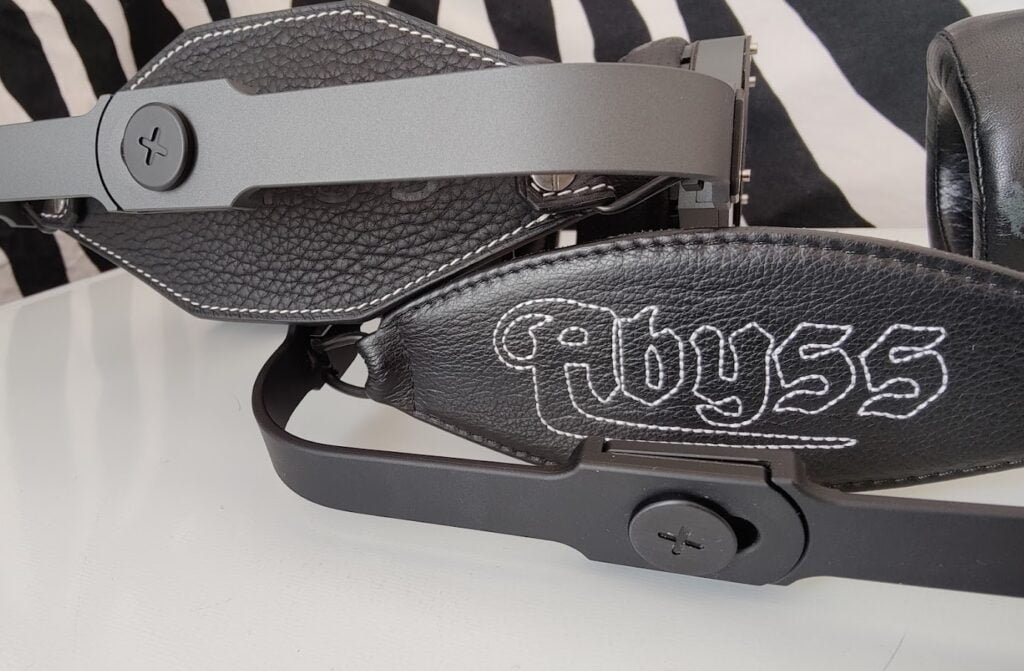
Main content:
The headband is held in place by rubber O-rings, as with the other products in the AB-1266 series. The new headband is wider and better cushioned than before. Furthermore, the O-rings are no longer sewn into the collar, but are secured with screws. This allows the owner of the headphones to replace the rings when they become loose. It would also be possible to try rings with different elasticity. In my review of the Phi, I mentioned that the leather part costs an unimaginable EUR 350 as a spare part. The strap, on the other hand, has a nice look that fits well with a EUR 7000 headset, and seems of such high quality that it could well last 10 years of use.
I don't see the new pan having a major impact on usability. In the beginning I found the padding on the TC even more uncomfortable than on the Phi, but after some loosening of the rubber tires, the comfort is now about the same or slightly better.
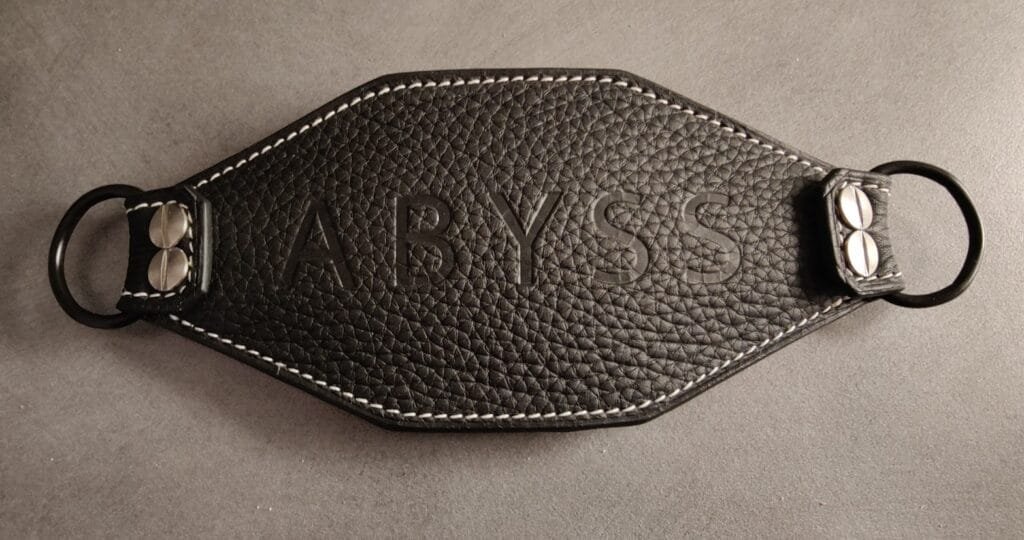
Ear cushions:
The new TC ear pads (also used on the CC model) are a couple of millimetres thicker and the outer edges are perforated. As the ear pads are not intended to be pressed against the head, the new design does not affect comfort at all. The fastening mechanism is still implemented with magnets, allowing the pads to be adjusted to different positions.
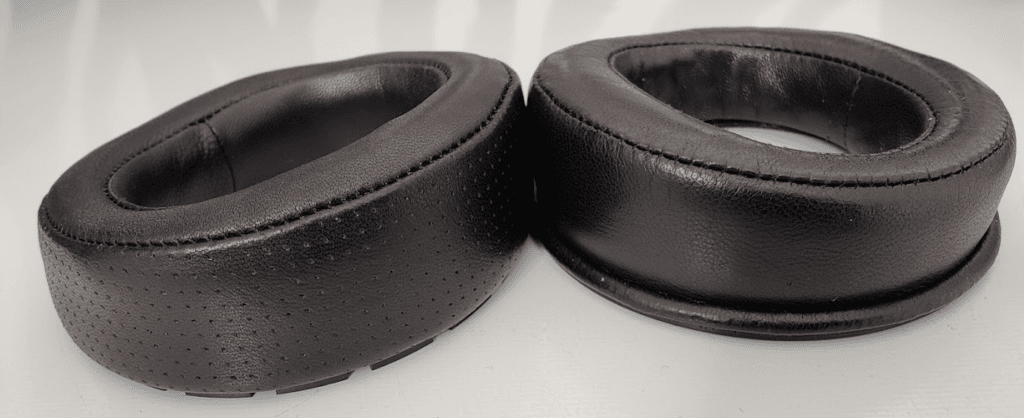
Other differences in appearance:
The structure of the foamed aluminium cups has changed slightly in the TC model. It is no longer as fine as in the Phi, but the pores are larger. The cups are therefore slightly more open than before. If the structure of the Phi were to incorporate the elements and padding of the TC, the result would not necessarily be identical. However, the differences in sound would probably be very small.
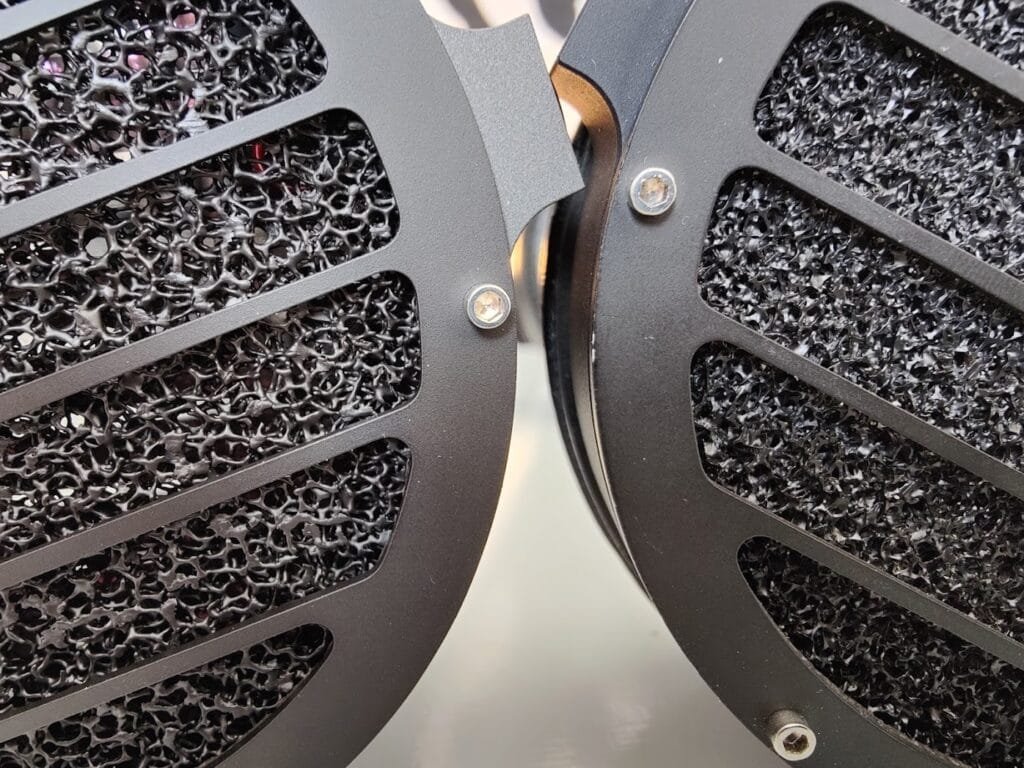
TC's all-new planar elements are the main and most sonically impressive innovation in the AB-1266 series. The new elements feature a diaphragm made of translucent material, while the Phi's aluminium foil-looking diaphragm is virtually invisible.
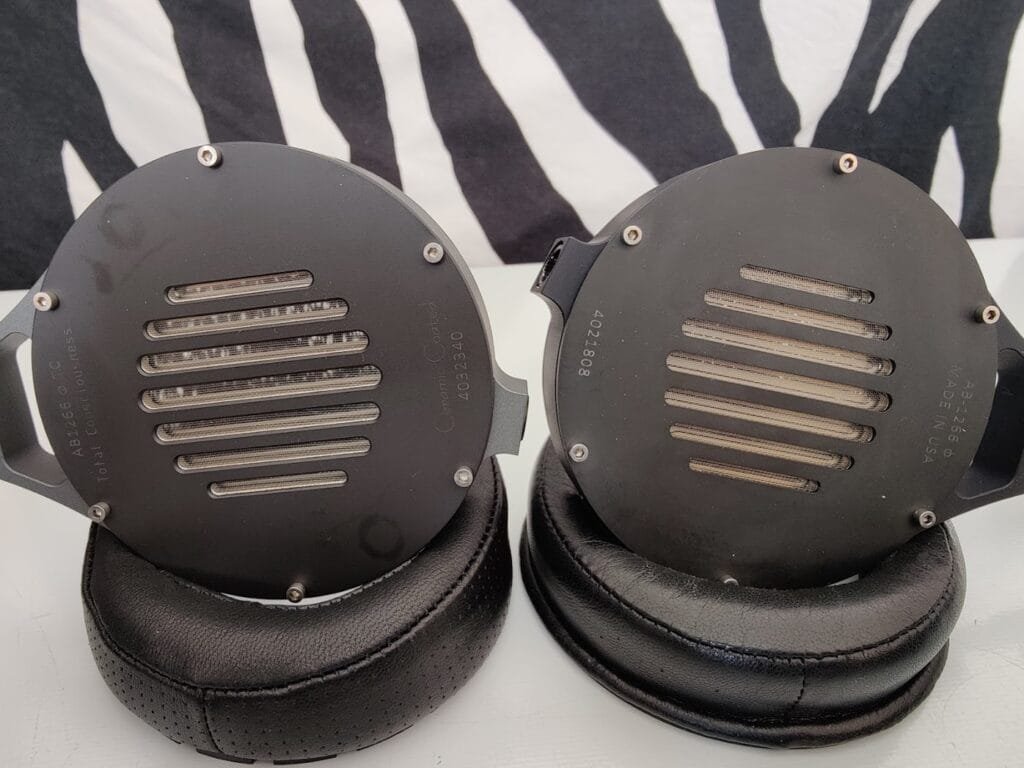
The appearance of the TC has also been enhanced by various engravings. A decorative engraving has been added to the inner surface of the top of the buckle and the country of manufacture and the manufacturer's logo on the sides - nice little touches.

Apart from the innovations I have described, the two AB-1266 models are functionally identical. The AB1266 Phi TC is not a beautiful headphone in the traditional sense, like products from Meze Audio or ZMF, but there is something intriguing about its "mischievousness". Not only are the materials and finish impeccable, but the AB1266 Phi TC is probably the most durable high-end headphone on the market. If it were dropped on the floor, one should be more concerned about the condition of the floor than the headphones themselves.
If Abyss added a more sophisticated and usable cable to their headphones, the whole thing would be almost perfect. The Superconductor cable included in the Complete package seems, from the videos I've watched, to be even stiffer and heavier than the cheaper basic cable.
As the basic design of the headphones has remained the same, there has been no major change in comfort. The wider headband is probably more comfortable for most people, but in my head the TC and Phi feel about the same. For me, the headphones are quite comfortable in use, but I am aware that not everyone can get them to sit properly on their head. The AB-1266 series are also heavy, so they definitely won't fit everyone either. However, I'm not bothered by the 640 gram weight, as the independent design of the headband distributes the weight very evenly.
Sound quality
The headphone frequency response measurements were made using IEC711 standard equipment and new, more accurate silicone ears (KB501X). The graphs use the scientifically based Harman target curve (2018 version) as a reference, which is a generalisation of the frequency response that most people think would sound good. For more information on the measurements and their accuracy, see Headphone Measurements-page. The frequency response of the AB1266 Phi TC is also comparable with other measured headphones comparison tool avulla.
Frequency response:
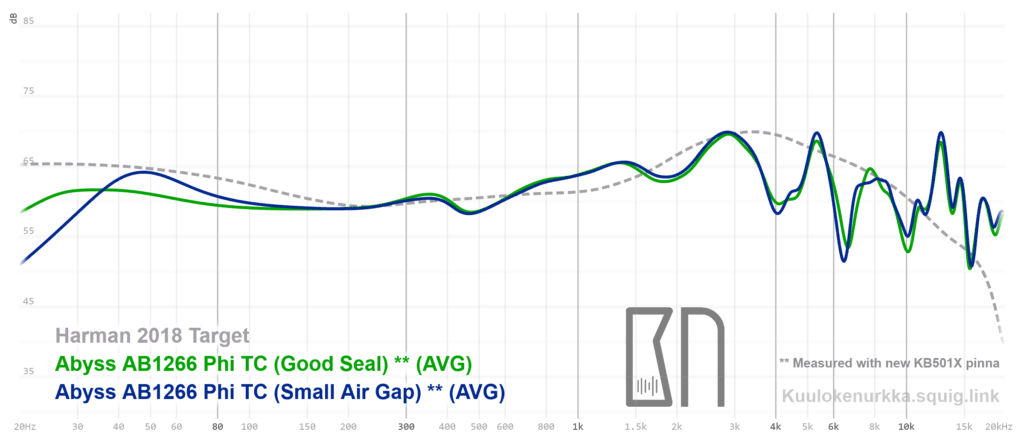
The above figure shows two different frequency responses, as the amount of alabaster bass in the AB-1266 models depends entirely on the air gap left between the head and the ear pads. I try to listen to the headphones with a small air gap (blue thread), as instructed by the manufacturer. However, my own listening impressions are more in line with the frequency response measured with a good seal in the green band, so the fit of the headphones on my head is likely to be slightly different from the fit on the ears of the measuring device.
Basso:
I was impressed by the Phi model, especially the bass, so my expectations for the TC were very high. It partly fulfils my expectations, because compared to the Phi, the low frequencies have more power and a sense of physicality, both in the impact and in the low bass rumble. While the headphones can never truly sound like speakers or mimic a subwoofer, some headphones can still be compared to large tower speakers while others sound more like small monitors. In such a comparison, the AB1266 Phi TC would be the headphone equivalent for a cinema, as its low frequencies are wildly fun to listen to.
However, one cannot speak of a "basshead" headphone if the ideal is Harman's target response, compared to which the TC is still quite restrained in terms of bass. Moreover, almost all modern closed-back headphones have more bass. This is something to be aware of if one is planning to jump straight into the deep end of headphone hobbyism with previous experience limited to the more affordable sealed headphones.
Nevertheless, the AB1266 Phi TC's bass is entertaining to listen to. If the headphones are perfectly positioned, the music is appropriate and the volume is just right, they can also deliver really accurate reproduction. However, there are far too many variables, so I often find that the bass response has lost some accuracy compared to the previous Phi model. At its worst, the TC model's bass is dull and slow, and the layering of the sound is lost in a monotonous thrum. At times, the TC also sounds a little out of phase, with a bass that seems to lag behind the rest of the music.
The most unusual sound is pop music, where the composition is rhythmically accompanied by a jumping simple bass. In my case, phase error was not a constant problem, but I would not want to run into that kind of problem on occasion. In the Phi model, crisp, controlled and fast bass was the so-called default mode of the headphones, while the TC only occasionally achieves this if all conditions are perfect. There's nothing inherently wrong with designing the headphones to sound fun rather than accurate, but for €6800 I'd expect to get much more accurate low frequencies.

Central votes:
I found the midrange of the older Phi model quite problematic. They sound very clean, but the uneven frequency response makes the sound thin and unnaturally thumping. The tinted presentation works well mainly with rock music. The TC model, on the other hand, no longer sounds machine-like like the Phi, but as a full-blooded rock headphone it is at least quite suitable for other types of music. Objectively speaking, there is still too much energy around 1 kHz, so many people may find the TC too aggressive. To my own ears, the more present upper midrange does a sufficient job of smoothing out this accentuation, helping to make the reproduction much more balanced and unencumbered.
Despite the improved midrange balance, the TC's midrange is still a curious combination of nasal congestion and airiness. The headphones sound as if some frequencies have been lightened with helium and others choked with congestion. This peculiar result is then topped with a curious echo. This is most noticeable when listening to the vocalist, so I've been listening more than usual to instrumental music and "noise metal" with the TC, where the naturalness of the vocal performances is not particularly important. For metal music, the Abyss headphones are really well suited anyway, because, for example, the fast-sawing guitars are played with ferocious fury.
The reverberant nature of the playback could explain the strange bass response, but the reverb is clearest in the midrange. The sound quality is clearly improved if I place my hands on the cups about an inch away from the headphones. The AB1266 Phi TC might benefit from a slightly more enclosed design. However, I believe that Abyss has deliberately built the headphones this way, as the specially resonant sound makes the soundstage feel bigger.
Treble:
The biggest improvement in frequency balance from the Phi to the TC model is in the upper frequencies. The previous model was far too bright in places, so with inappropriate music and equipment the result was almost unlistenable at worst. With the TC, however, I have not encountered similar excesses again. Based on the measured frequency response, the 4 kHz environment even sounds restrained, but I don't find the presentation particularly relaxed. Indeed, the most significant improvement in the upper frequency balance is probably the more restrained 6-8 kHz frequency range, which means that the TC no longer suffers from the Phi's sibilance problems. The TC sounds airy, precise and, above all, more pleasant than before.
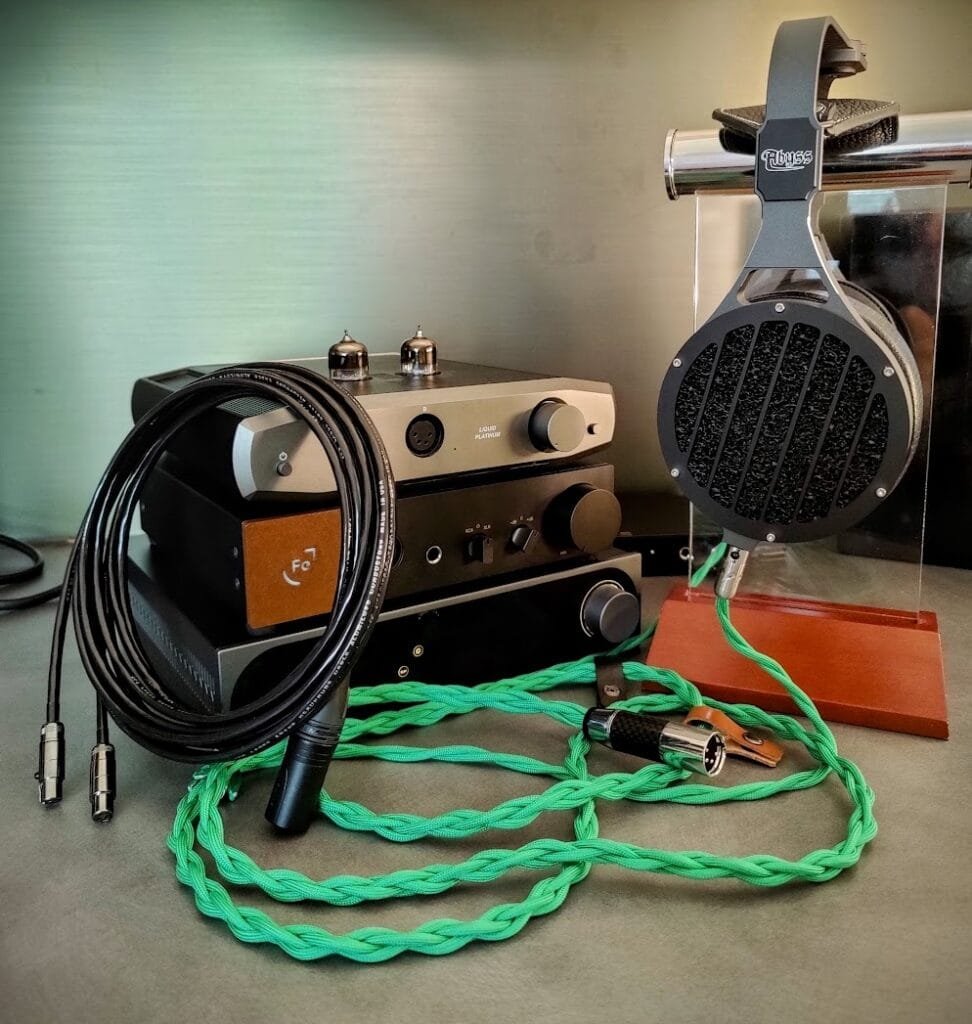
Audio description:
The two AB-1266 models I tried are very similar in soundstage, and they are among the largest hearing aid models I've heard in terms of spatial impact. The sound comes out of the headphones to ring out in front of me and around me. For example, while Hifiman HE1000 V2 and Sennheiser HD 800 have a large spatial impact, but their soundstage is bubbled compared to the AB-1266. When listening to most headphones, I find myself in a kind of bubble that defines the limits of the sound image. With the AB1266 Phi TC, however, the sound seems to come from somewhere outside, and the sound image doesn't seem to have any clear boundaries.
The accuracy of the sound placement is also first class. In this respect, the TC is actually a little better than before, because it allows me to pay attention to sound movements that I don't remember noticing on the Phi. In addition, the singer is more clearly delineated from the other voices in TC, resembling a real human being in shape and size. This is partly helped by the improved depth of the sound image in TC. Whereas the Phi model already crossed the boundary of realism with its "overly sharp" soundstage, the TC's accuracy of voice placement is at a ridiculous level. Individual clicks and fast sounds are reproduced with a precision that would never be possible in a room with normal acoustics.
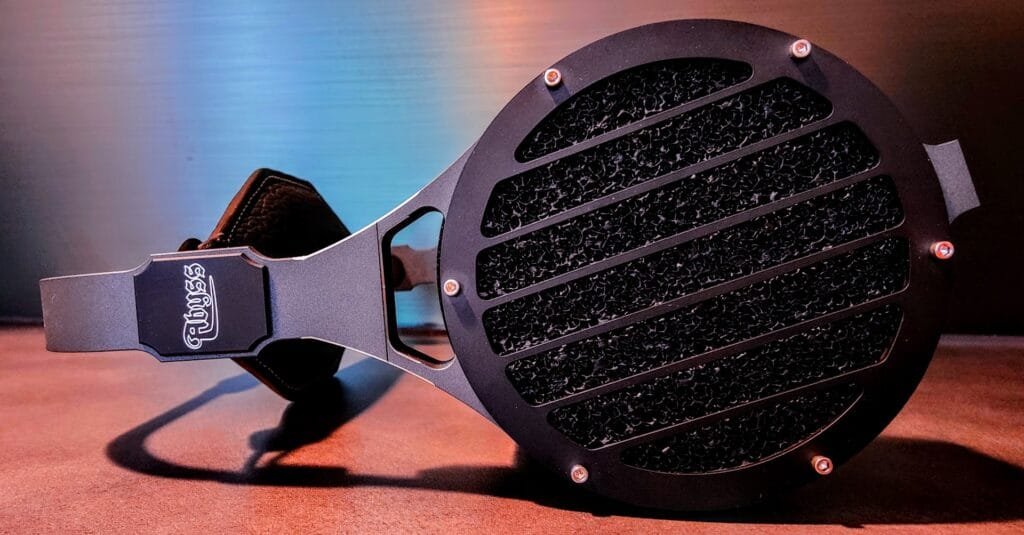
Dynamics:
I was impressed by the dynamics of the Phi, but to my surprise, the TC manages to improve it even further. The inspiring-sounding Phi was almost able to challenge Focal Utopian and Hifima's HE-6, while the TC is at least on a par with, if not ahead of, these headphones considered the kings of macrodynamics. In addition to the punchy repetition, the TC also has plenty of quietly uplifting dynamics that will make the listener involuntarily crawl to the edge of their seat.
Is the Abyss AB1266 Phi TC the best headphone in the world in terms of dynamics? It's quite possible, because it's at least the best headphone I've ever had the chance to listen to. When you combine wild dynamics with a huge soundstage, physical bass response and razor-sharp accuracy, I can sometimes forget all the TC's oddities.
Discrimination and sound masking:
Also in terms of resolution, the AB1266 Phi TC is one of the best headphones I've heard. There is a very clear separation between sounds, with very little unwanted merging except for problematic low frequencies. It's only the reverberant nature of the playback that compromises the headphones' ability to reproduce more subtle sound changes. However, the clarity of rapid impact sounds is stunning. When listening to music, it's easy to perceive a single sound or an area of the soundstage.
Despite its flexibility, the TC has a very clean sound, as the Focal Utopia, for example, which originally cost 4000 euros, doesn't sound very convincing. However, it has taken a step backwards in terms of reproduction detail compared to the previous Phi. This is probably largely explained by the different frequency responses of the headphones. The Phi's curious frequency response makes it exceptionally clear-sounding. In my opinion, the Phi sounds as if it was primarily designed to extract all the smallest overtones from the music as accurately as possible, while the TC is designed to reproduce rhythm and dynamics with a more fluid feel, even at the cost of a slight loss of sound transparency. This is quite a welcome change, as the TC is clear and discriminating, but not, like the Phi, self-promoting. Small nuances now sound as part of the music, where they can be easily found if desired, without the need for artificial detailing glued onto the presentation.

Confirmation
To get the most out of a top-of-the-range headphone like the AB1266 Phi TC, you need to put a lot of thought into the peripherals. The manufacturer recommends the dCS LINA Headphone Amplifier & DAC system to go with its headphones. The equipment costs EUR 25 500 or EUR 34 500 with the Master Clock box. When the equipment is linked together with the cables sold and recommended by the manufacturer, the price of the 'complete' AB1266 Phi TC set-up is close to EUR 60 000. Such a set-up could be considered a direct competitor to the EUR 62 000 Sennheiser HE1 headphone system.
Of course, few enthusiasts can afford or want to spend tens of thousands of euros on a hearing aid system. Fortunately, the sound of the TC can be enjoyed with a much smaller financial investment. The headphones have an impedance of 50 ohms, slightly higher than the 42 ohm Phi. The manufacturer claims a sensitivity of 88 dB/mW for both headphones, so the TC should be slightly harder to amplify than the Phi. However, from a hardware synergy point of view, the TC would seem to be the more forgiving of the two. I think the TC can be acquired without hesitation to try out if you own an inexpensive but reasonably powerful headphone amplifier. Better equipment can then be invested in later, if it is deemed necessary.
For example, the Topping L30 II, which costs €150, sounds pretty decent as a pair of headphones, without compromising on volume. However, the dynamics and spatial impression of the Topping leave a lot to be desired, as the sounds in the 'midrange' are too loudly clipped together and don't really separate from the background in terms of depth. In addition, there is no real sense of distance between the sounds at the edges of the soundstage.
The Monoprice Monolith Liquid Platinum hybrid amplifier, which costs around 700 euros, sounds much better. With some headphones, the sound is a bit aggressive and intrusive, as the sounds that come close come even closer than usual. However, the AB1266 Phi TC balances the Liquid Platinum's presentation, as the headphones' soundstage is naturally distant from the listener. The end result is intimate but not overly cramped. The three-dimensionality of the sound image, which is characteristic of the headphones, also comes across well, even though the size of the sound image is smaller than usual. The Liquid Platinum sounds so good with the TC that I haven't usually missed my more expensive amplifiers. Only the slightly unclear upper frequencies occasionally remind me that the TC is capable of even better.
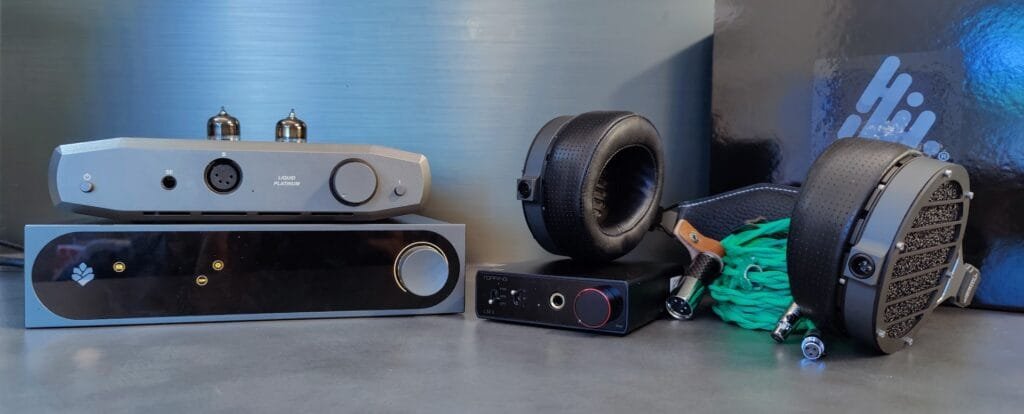
For my taste, the perfect amplifier for headphones would probably be a powerful tube amplifier, but good quality and powerful tube amplifiers tend to be annoyingly expensive. The Original OPA 4A, priced at around €850, is one of the few affordable tube amps that works reasonably well with even the most demanding planar headphones. The TC's midrange is a bit thin, so I prefer to listen to instrumental music with transistor amplifiers. The OPA 4A, on the other hand, adds a touch of lushness to the breathless midrange, allowing vocal performances to really shine through. After the OPA, I found it difficult to switch back to transistor amps, as they all sound a bit dry after a good tube amp. In addition, the transistor amps always have a kind of forced sound compared to the effortless sound of the OPA 4A.
In addition to more comfortable midrange, the tube amplifier improves the sound quality of the headphones. The soundstage of the AB1266 Phi TC with the OPA 4A feels deeper and more three-dimensional than other amplifiers I've tested. Unfortunately, however, it can't reproduce the lower frequencies with the accuracy I was hoping for, because at higher volumes the bass gets puffy, and eventually distorted. Swapping the 12AU7 standard tubes for Philips E80CC NOS tubes gave me more volume control, but the limitations of the amplifier still come into play too quickly. This is a shame, because with Philips tubes the OPA 4A offers the most comfortable sound of the amplifiers I tested.

Since the lower frequencies of the TC are quite problematic in any case, it didn't make sense to use a tube amplifier to make things worse. So I've been listening to headphones mainly with the Ferrum Audio OOR, which is my favourite amp, also with the Phi and the Hifima Susvara. The OOR doesn't do wonders for the AB1266 Phi TC's midrange, and it can't produce a soundstage as stunning as the Original OPA 4A, but there are no real flaws in the reproduction.
With OORs, dynamics and discernment are at the heart of the presentation. The soundstage is balanced and the overall imaging is uncoloured, but the mild softness of the amplifier makes the upper frequencies easy to listen to and the midrange a little tighter than usual. It should be noted, however, that the changes introduced by the amplifier are only small nuances in the sound, since the OOR is a line-slice amplifier, like any other properly functioning amplifier.

Abyss AB1266 Phi TC vs. Hifiman Susvara
Prices: €6800 vs €7000

Comfort and structure:
AB1266 Phi TC and my recently reviewed Hifima Susvara are as different in structure as night and day. The Abyss model conveys the manufacturer's pride in its product. The rigid construction looks as if it was designed to last for decades. While it's hard to imagine what a headset would have to be like to justify a price tag of €7,000, TC at least has the enterprise.
The more generic-looking Susvara, on the other hand, is not much different from the manufacturer's more affordable HE1000 series headphones. You have to hold it like a flower in the palm of your hand, because the nature of the construction doesn't inspire confidence in its durability. Even if handled with care, the Svara's cushioning will need to be replaced regularly, the leather part of the headband will become loose, and there's a high probability of cable breakage.
However, at 450 grams, it's exceptionally light for a large planar headphone, so the flimsy construction has its advantages. The AB1266 Phi TC weighs almost 200 grams more. The weight difference alone should be reason enough for many to choose Hifiman headphones over the two. I also find the Susvara slightly more comfortable to use, although this is more due to the different fit than to any other inherent comfort. The Abyss model sits quite comfortably on my head, but it is heavy. The cushioning on the cuff is a bit too thin for my ears, so I have to choose between the two, whether I want to put more strain on my neck or my earlobes.
Frequency responses:
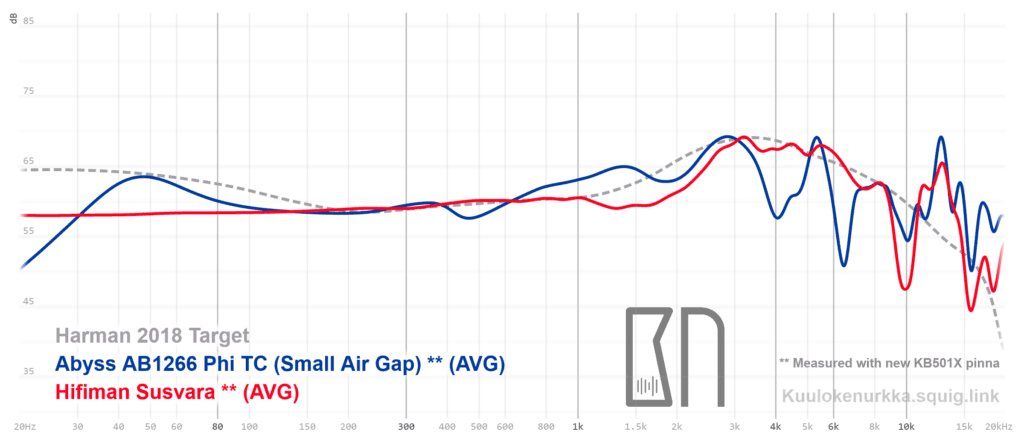
In my opinion, the success of a frequency response is not only determined by how closely the headphones match the selected target response. No one can say for sure what the perfect headphones should sound like, and what a truly neutral response should be. What all target responses have in common, however, is that they do not have sudden bumps or peaks. Based on this criterion, the Susvara clearly outperforms the AB1266 Phi TC, as its frequency response can be considered to be more or less perfect, taking into account the open structure.
Some may still need a completely different makeover compared to Svarva. For example, for those who prefer a "grado-like" sound, Susvara's restrained upper midrange may be a bit too choppy and refined. On the other hand, someone used to older Audeze headphones might find the treble too bright. Those who appreciate the kicky mid-bass of dynamic headphones may find that the Susvara's low frequencies need more power.
The Abyss model, with its special frequency response, may well appeal to the minority who, for one reason or another, do not like the objectively more balanced sound of the Susvara. The more powerful bass of the AB1266 Phi TC will certainly appeal to many, including myself. The headphones' 1-1.5 kHz range is overstated overall, but compared to the Grado headphones, the TC even sounds quite subdued. The bump at 4 kHz near the precession zone and the 5.5 kHz bump can sound good or awful depending on the music being listened to and the individual sensitivity of the user's ears to different frequencies. Compared to the Svaras, it would therefore be easy to judge the TC's frequency response as a failure, but I won't go there.
I came to an equally contradictory conclusion when I tried to compare the headphones based on other measurements. Based on the information I found from various sources, the Susvara is more or less the perfect headphone, for example because it has exceptionally low distortion. Even at low frequencies, distortion is less than 0.5%. The AB1266 Phi TC, on the other hand, has problems with high distortion if the headphones are listened to louder. The TC's phase error has also been verified by measurement. So on paper the Susvara is more capable, but what about in practice?
Subjective observations on the sound of headphones:
Comparing the AB-1266 TC version to the Susvara is not much different in outcome from the comparison I wrote earlier between the Phi and the Susvara. The Susvara's nuanced midrange sounds great, and the Abyss model, which sounds like a colossus, is nowhere near as good. Unlike the headphone Phi, the TC is not as capable in the low frequencies, although it is still excellent at its best. Phase errors are all too frequent, so most of the time I've found the Susvara's bass to be of higher quality, although I prefer the Abyss's richer bass in other respects.
The TC is clearly larger in sound, and more precise in the placement of the voices. Susvara's sound is very accurate, but the Abyss model is even better. In terms of dynamics, the headphones are not comparable, as the restrained Hifiman is no match for the TC, which is by far the best headphone I've heard by this measure.
When comparing the transparency and discriminatory power of playback, I'm a bit in two minds. One might imagine that Susvara would benefit from a more balanced frequency response, but in practice I have not found that the Abyss model 'hides' anything, even if it does sometimes emphasise some frequencies at the expense of others. Susvara's serene and even slightly flat presentation makes it sound less detailed than it is. It's sometimes very difficult to judge discrimination, especially when the headphones being compared are among the best in the world in this respect. But it's easier to judge the clarity, or rather the lack of it. I find the AB1266 Phi TC a little more effortless to "look" into the music.
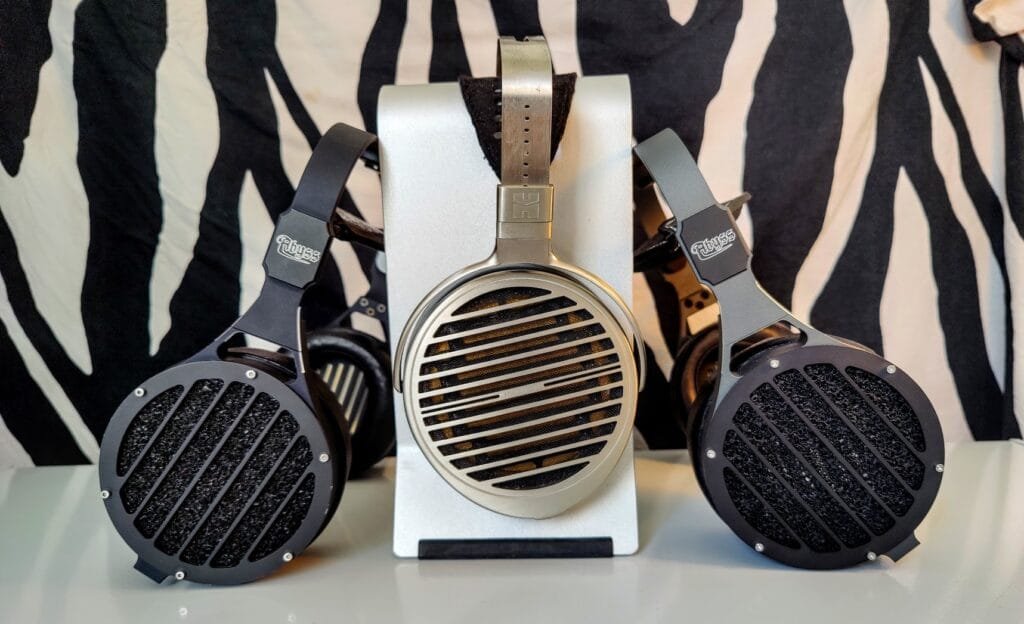
If the Susvara and AB1266 Phi TC were cheaper, I'd be happy to keep both headsets. The two sound quite different and are at their best with different styles of music. The more balanced sound and great midrange of the Susvara is what attracts me. Objectively speaking, it is the better of the two because there are no major flaws in the sound quality. However, the Abyss headphones are more interesting and generally more fun to listen to, even if the oddities of the presentation can sometimes be annoying. Sometimes, choosing a better product cannot be done by reason alone or by listing pros and cons. In the end, the Abyss AB1266 Phi TC makes me want to own it more than the Hifima Susvara.
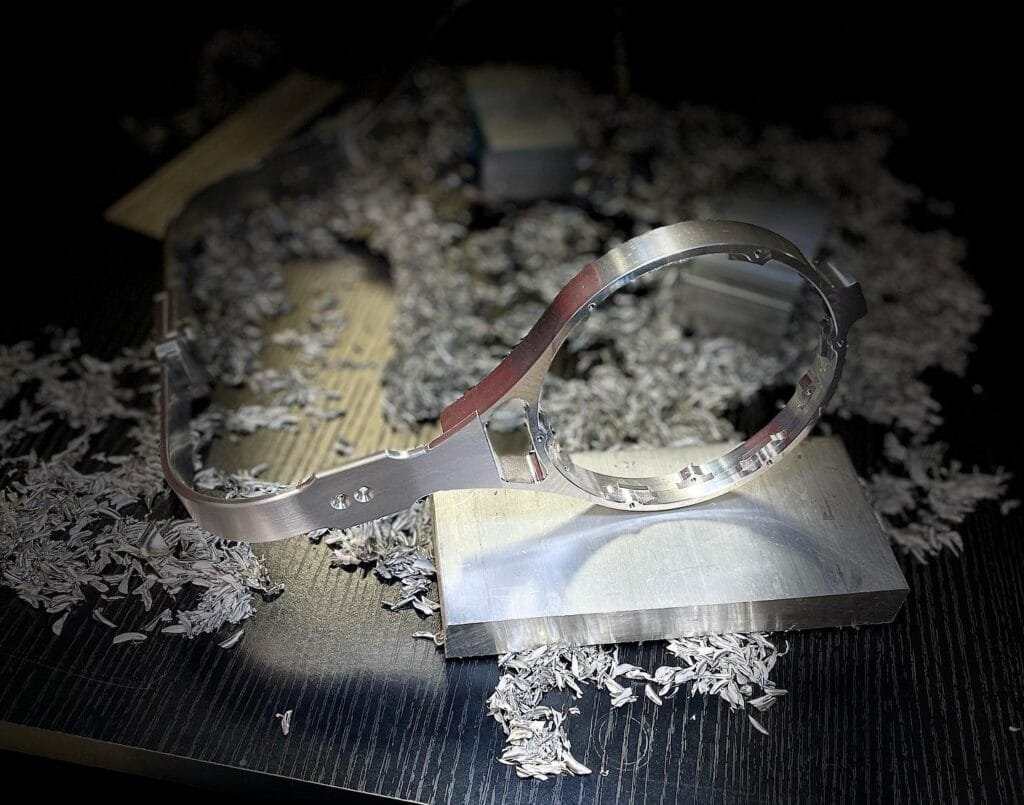
Summary
At its best, Abyss AB1266 Phi TC is jaw-droppingly gorgeous, making the thought of one more song easily stretch into a five-hour marathon. The headphones hit like a sledgehammer in terms of dynamics, but reproduce the music with surgical precision, a rare combination indeed. In terms of construction, the headphones are almost perfect, apart from the odd cable. Although there's a fair bit of weight, comfort is better than you might expect.
Unfortunately, phase-mismatched bass, echoing midrange and an odd frequency response are major sound quality weaknesses. Given these serious faults, it's almost surprising that the headphones sometimes sound near-perfect. The stunning soundstage, transparency of reproduction and unimaginable dynamics compensate surprisingly well for these weaknesses. However, how far this will be enough for each of them is a question mark. As with the Phi I reviewed earlier, it is difficult to recommend the TC as a blind purchase. However, for those who prefer a more distinctive sound, the Abyss AB1266 Phi TC could be the mythical last headphone purchase after which you can stop stalking the novelties and concentrate on enjoying the music.
Pros and cons:
+ For all its oddities, an outrageously entertaining package
+ Playback transparency and detail resolution
+ The best dynamic headphones I've ever heard
+ A large and vivid soundscape, with accurate placement and layering of sounds that feel authentic
+ Exceptionally rigid and high-quality construction
+ 10-year warranty for the first owner
+ Safe purchase even when used, as the 2-year warranty is transferred to the next owner and the manufacturer offers a repair service even after that.
-/+ The headphones are heavy, but surprisingly comfortable when fitted correctly
-/+ Requires a fairly powerful amplifier, but is not particularly demanding in terms of hardware synergy
- Phase error in the bass sound
- Elastic middle range
- The frequency response is more correct than before, but the tonal balance is still quite peculiar
- Familiarisation required due to the unusual design of the headphones
- Headphones cannot be used with ear cushions from other manufacturers
- Impractical cable
- Very high price